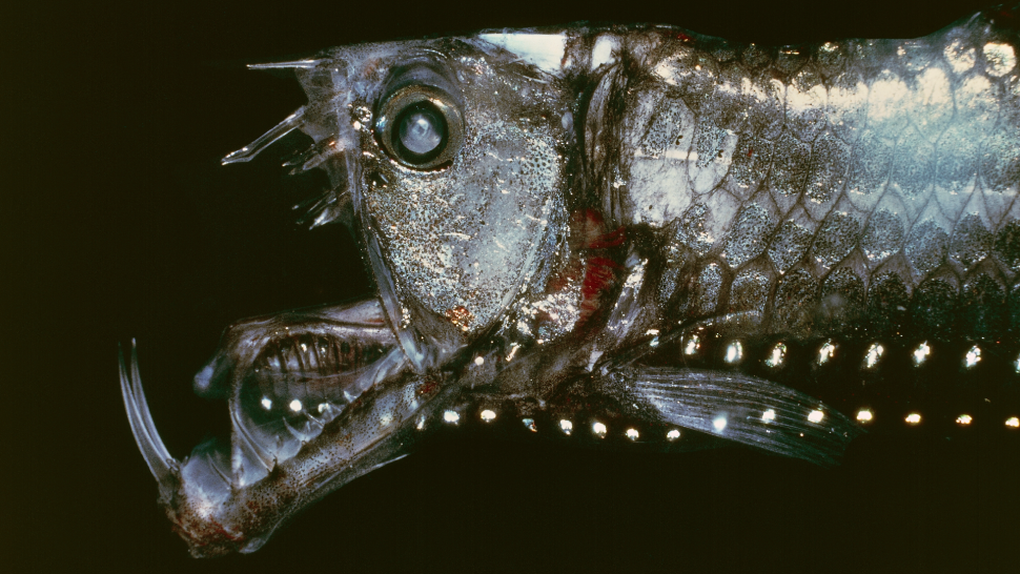The truth behind the strange appearance of deep-sea fish
Deep sea fish have developed unique characteristics to take advantage of the harshest habitat on Earth.

The Sloane viper fish has large, transparent teeth and a strip of light-emitting organs called photophores along its abdomen. These are the characteristics that help it survive in the deep sea (Photo: Getty).
Many species of fish living on the ocean floor will probably make you shiver when you see their appearance. So much so that there was a period when people had to use the nickname “sea monster” to talk about them.
We’re talking about fish with gaping mouths, eyes that are cloudy and bulging out of their retinas, bodies that glow in the dark, sharp fangs pointing outwards.
But the question is why do these fish have such strange characteristics?
According to Mary McCarthy, a marine biologist at the Monterey Bay Aquarium, California, USA, the strangeness of deep-sea fish largely reflects the harsh environment in which they live.
“The deep sea is a really tough place to make a living,” McCarthy said. “A lot of animals have had to make some adaptations to survive in that environment.”
If the image of fish swimming around at the aquarium, next to coral reefs, sea stars… makes you admire the beauty of the seabed, in reality things are much harsher than that. .

Anglerfish (genus Melanocetus) use bioluminescence to attract prey in the deep sea (Photo: MBARI).
At a depth of about 200 meters below the surface, there is little or no light. It also has high pressure, limited food sources, and is much colder than the rest of the ocean. It is estimated that the average temperature is only about 4 degrees Celsius above freezing.
Because they don’t have many opportunities to find food, deep-sea fish have developed a number of characteristics that help them catch prey. One of them is a giant, wide jaw.
For example, the Sloane viper fish (Chauliodus sloani) has fangs so large that it cannot close its mouth. Because if they do, they will pierce their own brains.
These razor-sharp teeth also have strange colors, when completely transparent. This helps them hide their “weapons”, making it impossible for their prey to notice before it’s too late.
Other deep-sea fish such as the pelican eel (Eurypharynx pelecanoides) have a mouth that takes up most of their body, allowing them to catch and swallow large fish.
Some deep-sea predators have a secret weapon that makes them “magnets” for hunting. That’s bioluminescence — or the ability to form a light source.
The most famous of these is the “fishing rod fish” – of more than 200 different orders – which have the ability to lure prey by using a glow-in-the-dark light on the rod-like part attached to their head. .
This light attracts smaller sea creatures to where food sources are limited. While the poor prey thought they were about to devour a tiny luminescent creature, in reality they were about to become a meal for the fearsome predator.Most of these fish have dark gray or dark brown colors, large heads and huge crescent-shaped mouths filled with sharp teeth.
Some deep-sea fish, such as the giant hatchetfish (Argyropelecus gigas), can dim their lights to match their surroundings. This is a mechanism that helps them both attract prey, but also hide from potential enemies.

Droplet fish live at a depth of 1,525 meters below the sea surface (Photo: UW/NSF-OOI).
This emission, or change, of light is the result of a chemical reaction in the fish’s body. There, a light-emitting compound called “luciferin” combines with the “luciferase enzyme” to create a photon – or particle of light.
Another common feature in the deep sea is the weak body structure of the animals.
Located in the waters outside Australia and Tasmania, the “waterdrop fish” (Psychrolutes marcidus) lives at depths of 600 – 1,200 meters, where pressure can be more than 100 times that at the surface.
To survive in this harsh environment, the waterdrop fish has adapted an unusually soft body, and does not have a proper skeleton.
This causes when the fish are brought close to the surface of the water, they will collapse, looking like a gelatinous mess. This is also the reason they were dubbed “the world’s ugliest animal” in 2013.
Strange or ordinary?
However, all these characteristics are completely normal, not at all weird for them. Just as deep-sea creatures might ask similar questions, when they see land-dwellers.
“The deep sea environment is very dark, cold, has low oxygen and high pressure, so it will be different from what we are familiar with,” McCarthy explained. “Those are strange features to us, but extremely normal to them.”





